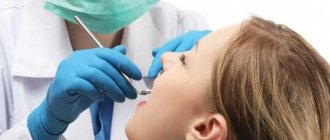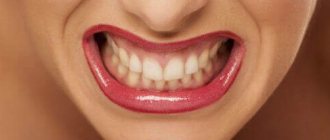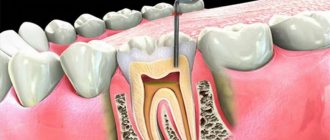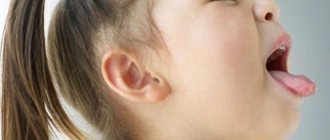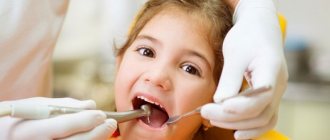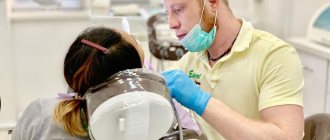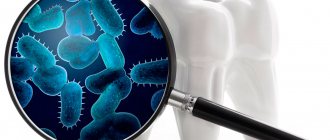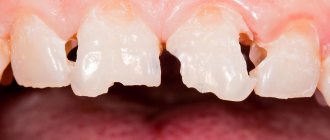Most people who do not have special knowledge in the field of dentistry believe that periodontitis is an inflammation of the gums. In fact, this is only partly true, since with this disease not only the gums become inflamed, but also the process of destruction of the periodontium begins - the tissues that fix the tooth in the bone. As a result, the tooth loses contact with the gum, and the patient can easily lose the tooth.
In children, periodontitis is diagnosed much less frequently than in adults, and has some differences in the nature of the disease.
Forms of periodontitis in children
Depending on the age period, experts distinguish two forms of this disease in children:
- Prepubertal periodontitis
Characteristic of young children (up to 10 years), most often occurs during teething or immediately after this process is completed.
This form is asymptomatic, the child does not experience pain. A characteristic sign of the disease is a white coating on the teeth and gums and loosening of baby teeth. If treatment is not started as soon as possible, teeth will fall out much earlier than expected.
The danger is that there is severe destruction of the bone tissue around the teeth, and the pathological process begins to affect the rudiments of permanent teeth, which subsequently causes serious problems in their growth and development.
- Adolescent (pubertal) periodontitis
As the name suggests, it occurs during adolescence. With this form, the alveolar processes of the jaws are rapidly destroyed.
The child may complain of itching, swelling of the gums and fever, bad breath, and thick saliva. In later stages, pus begins to ooze from the periodontal pockets.
Types and stages of gum periodontal disease
The disease can take a chronic or acute form. And depending on the spread of the pathology, the following types of periodontal disease are distinguished:
- localized periodontal disease - with exposure of the dental necks in a certain area of the jaw;
- generalized periodontal disease - with characteristic symptoms throughout the entire dentition.
The disease can develop over years, so in dentistry it is customary to divide its development into several stages.
- Initial. Subtle changes in periodontal tissues that can only be determined by a specialist.
- First. Slight receding gums. Teeth occasionally react to cold or hot.
- Second. Significant exposure of the necks of the teeth, increased sensitivity, the appearance of interdental gaps, and in some areas - cement instead of enamel.
- Third. Gum recession of more than 50%. Eating food often causes discomfort. The teeth gradually begin to loosen.
- Fourth. Advanced disease with gum receding by more than 65%. The teeth are loose, which makes it difficult to eat and talk. The x-ray shows that only the tip holds them in the bone.
Causes of periodontitis in children
- the most common is insufficient oral hygiene, which causes the proliferation of harmful bacteria in the baby’s mouth;
- abnormalities in the growth and development of teeth or jaw bones (for example, malocclusions) - in this case, the process of chewing food is disrupted, which leads to problems with the gums;
- the habit of chewing only on one side - in this case, the second half of the teeth is not cleared of food particles and a characteristic plaque appears on them;
- congenital defects in the structure of the lips, tongue, as well as a short frenulum - all of them provoke an increase in the number of harmful microorganisms in the oral cavity, since they negatively affect the chewing process;
- gum injuries - they can be caused by reasons such as the habit of biting nails or objects (pencils, pens), excessive consumption of hard foods.
How is it classified?
To draw up a treatment regimen, it is important to conduct a detailed diagnosis and determine the characteristics of the disease.
Periodontal disease occurs:
- localized - destruction of the tissues of one or several teeth;
- generalized - destructive processes affect the entire jaw.
This is a chronic, sluggish, progressive disease. The acute form is rare, since the pathology is not infectious. In the acute period, bleeding from the gums, pain, and discomfort during chewing are observed.
The progress of periodontal disease is divided into stages according to the degree of pathological changes in bone and soft tissue.
Features of the treatment of periodontitis in children
If you suspect your child has periodontitis, contact a specialist immediately. Only doctors can confirm such a serious diagnosis and give recommendations for treating the disease.
In this case, first of all, it is necessary to identify the cause of the disease and, depending on this, take certain measures: correct the bite, teach the baby to brush his teeth correctly or trim the frenulum.
In addition to eliminating the cause of periodontitis, comprehensive treatment must be carried out, which must be prescribed by a doctor.
Do not forget that to prevent this dangerous disease, it is almost always enough to ensure that the child observes oral hygiene. The child should brush his teeth 2 times a day, brushing for at least 2 minutes. Don’t be lazy to control the process, observing how correctly it is proceeding. And be sure to make sure that the toothpaste is appropriate for the baby’s age, and the brush is changed every 3 months. To maintain dental health, use Asepta toothpastes from the Baby, Kids and Teens series. They carefully clean the enamel, saturate it with calcium, strengthen teeth and prevent the development of caries.
Cost of treatment
With early diagnosis, treating periodontal disease will be faster and cheaper than in the later stages. The price is influenced by diagnostic methods, treatment, area of tissue damage, number of visits to the doctor and other factors.
Our clinic provides accurate diagnostics, professional cleaning of teeth from stone, antiseptic treatment in case of infection, splinting, and installation of dentures. Our doctors work with modern equipment and use only effective, safe drugs and materials. We always strive to preserve the integrity of the dentition. If this fails, we install high-quality implants.
You can make an appointment with a periodontist by phone. The treatment plan and prices are discussed with the patient before the start of the procedures.
Sources
- da Silva FG., Pola NM., Casarin M., Silva CFE., Muniz FWMG. Association between clinical measures of gingival inflammation and obesity in adults: systematic review and meta-analyses. // Clin Oral Investig - 2021 - Vol - NNULL - p.; PMID:33904994
- Wang Y., Mo Y., Peng M., Zhang S., Gong Z., Yan Q., Tang Y., He Y., Liao Q., Li X., Wu X., Xiang B., Zhou M ., Li Y., Li G., Li X., Zeng Z., Guo C., Xiong W. The influence of circular RNAs on autophagy and disease progression. // Autophagy - 2021 - Vol - NNULL - p.1-14; PMID:33904341
- Qian L., Shujuan G., Ping H., Li L., Weiwei S., Yafei W., Weidong T. Wnt5a up-regulates Periostin through CaMKII pathway to influence periodontal tissue destruction in early periodontitis. // J Mol Histol - 2021 - Vol - NNULL - p.; PMID:33904122
- Ma X., Wang Y., Wu H., Li F., Feng X., Xie Y., Xie D., Wang W., Lo ECM., Lu H. Periodontal health related-inflammatory and metabolic profiles of patients with end-stage renal disease: potential strategy for predictive, preventive, and personalized medicine. // EPMA J - 2021 - Vol - NNULL - p.1-12; PMID:33903806
- Ndjidda Bakari W., Thiam D., Mbow NL., Samb A., Guirassy ML., Diallo AM., Diouf A., Diallo AS., Benoist HM. New classification of periodontal diseases (NCPD): an application in a sub-Saharan country. // BDJ Open - 2021 - Vol7 - N1 - p.16; PMID:33903592
- Cho YD., Kim WJ., Ryoo HM., Kim HG., Kim KH., Ku Y., Seol YJ. Current advances of epigenetics in periodontology from ENCODE project: a review and future perspectives. // Clin Epigenetics - 2021 - Vol13 - N1 - p.92; PMID:33902683
- Scannapieco FA., Dongari-Bagtzoglou A. Dysbiosis revisited. Understanding the role of the oral microbiome in the pathogenesis of gingivitis and periodontitis: a critical assessment. // J Periodontol - 2021 - Vol - NNULL - p.; PMID:33902163
- Yao S., Jiang C., Zhang H., Gao X., Guo Y., Cao Z. Visfatin regulates Pg LPS-induced Proinflammatory/Prodegradative effects in healthy and inflammatory periodontal cells partially via NF-κB pathway. // Biochim Biophys Acta Mol Cell Res - 2021 - Vol - NNULL - p.119042; PMID:33901513
- Meng X., Wang ZF., Lou QY., Rankine AN., Zheng WX., Zhang ZH., Zhang L., Gu H. Long non-coding RNAs in Head and Neck Squamous Cell Carcinoma: Diagnostic biomarkers, Targeted therapies, and Prognostic roles. // Eur J Pharmacol - 2021 - Vol - NNULL - p.174114; PMID:33901464
- Li L., Bao J., Chang Y., Wang M., Chen B., Yan F. Gut Microbiota May Mediate the Influence of Periodontitis on Prediabetes. // J Dent Res - 2021 - Vol - NNULL - p.220345211009449; PMID:33899584
Degree of tooth mobility
Classification of tooth mobility, indicating the degree of development of the disease:
- Stage I - slight pathological mobility of teeth in the vestibulo-oral, bucco-lingual directions;
- Stage II - the possibility of displacement of the incisors by more than 1 mm in the same directions, mobility appears in the palatal-distal direction;
- Stage III - teeth are mobile in all directions, tilts in different directions are possible;
- Stage IV - pronounced mobility in all directions, the ability to move around its axis.
The degree of tooth mobility indicates the severity of periodontitis and the rate of development of the disease.
Causes of development and symptoms
Hygiene plays an important role in disease prevention. After eating, a soft plaque forms on the surface of the teeth, in which bacteria actively multiply, damaging the enamel. If hygiene procedures are not carried out in a timely manner, then over time the dental plaque becomes hard, tightly bends around the neck, causes inflammation of the gums - gingivitis develops. If left untreated, the pathology progresses and turns into periodontitis (see photo).
In addition to the main cause, the development of the disease is influenced by the following traumatic factors:
- hypertonicity of the masticatory muscles;
- abnormal position, crooked teeth;
- poor-quality prosthetics with crowns, implants or fillings (there are no interdental spaces left, sharp, protruding parts that injure the gums);
- bridles and cords are attached high;
- mechanical injuries, exposure to aggressive substances.
At risk are patients with blood diseases, immunodeficiency, diabetes mellitus and other diseases that are accompanied by periodontal syndrome. Some chronic pathologies may increase the risk of periodontal inflammation.
Is periodontitis contagious? Since it is infectious in nature, pathogenic microorganisms can be transmitted from person to person. However, provoking factors lead to the occurrence of the inflammatory process, so a person can remain healthy even if he is in close contact with a sick person.
Signs of periodontitis:
- pain, swelling, red gums, bleeding;
- the presence of periodontal pockets, exposure of roots;
- viscous saliva;
- more dense plaque;
- unpleasant odor;
- increased sensitivity to cold and hot temperatures of food, drinks, air;
- looseness, displacement, loss of teeth;
- purulent discharge, fistulas, abscesses on the gums;
- swelling, pain of the submandibular lymph nodes.
Symptoms depend on the type and severity of the disease. If soft tissues are constantly injured, then the pathology has an acute form with severe pain and inflammation. In the presence of dental plaque, gum pockets form into which food gets trapped and bacteria multiply. An inflammatory process occurs, which at first may be mild. During periods of exacerbation of the chronic form, symptoms worsen. If the disease is not treated, the destructive processes continue, and eventually the teeth fall out.
How to protect baby teeth from caries?
Prevention is the best way to cope with any disease. Therefore, those parents who care about the health of their children should definitely think about caries prevention. How to protect baby teeth from caries? The recommendations of experts in this matter are as follows:
- The correct diet for the mother during pregnancy is with a sufficient amount of foods containing calcium, fluorine and phosphorus: cottage cheese, beef and beef liver, sea fish, nuts, fruits and vegetables, cereal porridges.
- Compliance with hygiene standards: daily brushing from the moment the first teeth appear, first with a cotton or gauze swab with boiled water, then with special baby brushes and pastes. Plaque on baby teeth should be removed promptly and thoroughly.
- A healthy diet for a child: as little fast carbohydrates, carbonated drinks, sweets as possible, more fruits and vegetables, cereals, and dairy products.
- Timely visits to the dentist for preventive examinations (at least once every six months).
It is important that parents develop a conscious attitude towards the health of their children's teeth and oral cavity in general. A timely visit to the dentist in case of any identified problems, as well as for regular medical examinations, will help maintain the health of the child’s dental system – and therefore the digestive system too.
